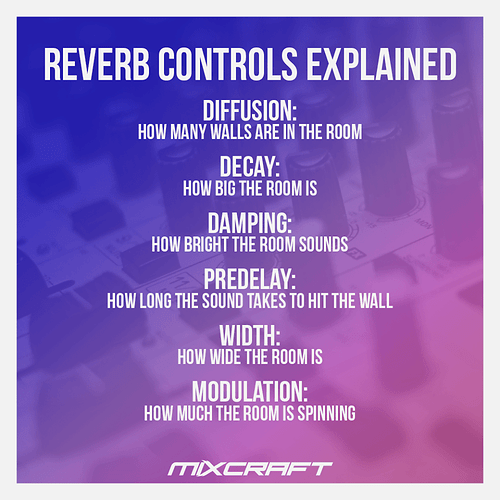The nice folks at Mixcraft posted this today. Looks pretty nifty to me, helps visualize what’s happening with the various aspects of reverb. I know I certainly have been confused more than once by which parameter had which outcome… Thoughts?
Cool stuff… Very nice.
…Though decay and width being described as big vs wide seems sort of ambiguous. Maybe…
Decay: how long it takes the reverb to go away
Width: how spread-out and spacey the reverb sounds
I assume this is talking about a room/hall emulation. I can’t remember if there’s a diffusion parameter on most plate verb emulators.
Also, I’m guessing they left early-reflections off because maybe there isn’t an early reflections controller on the mixcraft reverb?
I’ve always been a fan of categorizing things and finding simple words to conceptualize big concepts. KISS (keep it simple stupid!) 
Yeah, that seems like a pretty accurate set of descriptions, although some don’t quite translate literally, like the ones you mentioned. Close enough to get what it’s talking about though.
Also, I wouldn’t think of decay as room size, even though it’s generally correlated. I’ve been in tiny echo chambers that have decay for days, and big rooms that decay quickly.
I had predelay explained to me something like this - the reverb depends on how big the room is, and the predelay is how far you you’re standing from that source in that room. Now I can’t put delay on anything without thinking about that
I understand that in technical terms more as - how soon the sound signal is processed by the plugin or equipment. As in for how long do you hear the “dry signal” before you start hearing the effect applied. In a way it could be translated into distance from the source but vaguely.
That’s how I understand (and use) it. You get to hear the dry signal first for whatever number of milliseconds of pre-delay you dialed in, after that the reverb kicks in. This is sort of the best of both worlds: you get a dry, in your face signal first and the reverb tail afterwards which gives the perception of space. What I’m not so sure of is what happens to the early reflections. In a natural space (like a small room) you would hear these very quickly after the first signal. I would imagine early reflections would sound strange and unnatural when they start after a substantial pre-delay. So I wonder: what happens to early reflections when dialing in pre-delay? I’m sure Boz can tell us 
Early reflections arent related to predelay as far as I know. Early reflections are usually exact replicas (non diffused echoes) that you hear almost immediately within a few discern-able milliseconds. They are usually equal energy echoes that give our ears a sense of space immediately.
If we were to combine early reflections with predelay, if its a plugin or a device, the early reflections wouldnt even kick in until the predelay timer is exhausted. We could however use a parallel signal with zero predelay and early reflections along with a dry signal to simulate what you are describing I guess?
As for pre-delay I am not even sure if pre-delay is a true acoustic phenomenon at all … or simply an electronic/digital processing phenomena. I have been searching for that answer myself…
Makes me feel so much better to know that I am not alone on that quest! This discussion has been super useful. Thanks y’all!
